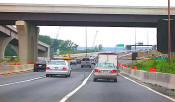 |
I-95/I-495 Capital Beltway, westbound (Inner Loop)
in Maryland, on the newly-opened 3-lane roadway, in the I-295 interchange.
The new I-295 interchange is under construction, as part of the WWB Project. |
 |
I-95/I-495 Capital Beltway, westbound (Inner Loop)
in Maryland, on the newly-opened 3-lane roadway, approaching the newly-opened
new Woodrow Wilson Bridge. |
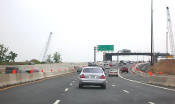 |
I-95/I-495 Capital Beltway, westbound (Inner Loop)
in Maryland, on the newly-opened 3-lane roadway, approaching the newly-opened
new Woodrow Wilson Bridge. |
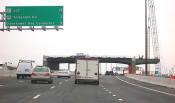 |
I-95/I-495 Capital Beltway, westbound (Inner Loop)
in Maryland, on the newly-opened 3-lane roadway, approaching the newly-opened
new Woodrow Wilson Bridge. |
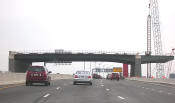 |
I-95/I-495 Capital Beltway, westbound (Inner Loop)
in Maryland, on the newly-opened 3-lane roadway, approaching the newly-opened
new Woodrow Wilson Bridge. The overpass
under construction is for the pedestrian and bicycle trail that will connect
from the north side of the new bridge, across Rosalie Island, to Maryland.
The pedestrian and bicycle trail across the new bridge will connect the system
of pedestrian and bicycle trails in Maryland and Virginia. |
 |
I-95/I-495 Capital Beltway, westbound (Inner Loop),
on the newly opened 3-lane roadway leading to the first new 6-lane Woodrow
Wilson Bridge. The Maryland end of the bridge is visible ahead. |
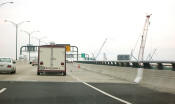 |
Similar vantage point as the previous photo, but
taken on a different trip across the bridge, in the right lane. The Maryland
end of the bridge is visible in the foreground where the asphalt (dark) pavement
meets the concrete (light brown) bridge roadway deck. Notice the 10-foot-wide
right emergency shoulder on the bridge, which extends across the entire new
bridge. The original bridge had a 7-foot-wide right emergency shoulder on
all of the bridge, except with a shoulder on the drawspan that was only about
2 feet wide. |
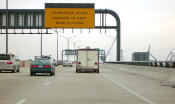 |
New Woodrow Wilson Bridge, heading westbound toward
Virginia. The maximum
grade on the new WWB Maryland approach is 2.30% near the Maryland shore, and
is 1.20% approaching the high point of the bridge. This photo shows the Beltway
Inner Loop third advance warning sign for the drawspan of the Woodrow Wilson
Bridge. |
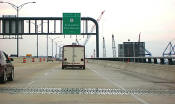 |
New Woodrow Wilson Bridge, heading westbound toward
Virginia. Notice the transverse bridge expansion joint visible directly ahead.
The raised bascule spans of the original WWB, are visible to the right, and
they will remain raised until the original WWB is demolished. |
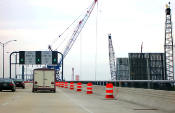 |
New Woodrow Wilson Bridge, heading westbound toward
Virginia. The raised bascule spans of the original WWB, are visible to the
right. |
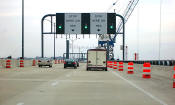 |
New Woodrow Wilson Bridge, heading westbound toward
Virginia. This photo shows the Beltway Outer Loop final warning sign for the
drawspan of the Woodrow Wilson Bridge, and it has green, yellow and red signals
to control traffic. |
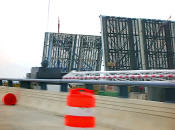 |
Closer
view of the raised bascule spans of the original Woodrow Wilson Bridge. |
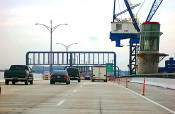 |
New Woodrow Wilson Bridge, heading westbound toward
Virginia. The bascule span (drawspan) and the highest point of the bridge
is ahead. The drawspan Operator's Tower is visible to the right. A nice feature
about the drawspan on the new bridge, is that its roadway deck is made of
reinforced concrete; and while it is much heavier than the original bridge's
drawspan steel grid roadway deck, it won't have the problem of it being slippery
when wet. |
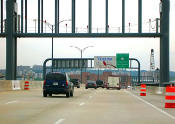 |
New Woodrow Wilson Bridge, heading westbound toward
Virginia. The bascule span has been passed, and the roadway has a downgrade
to the Virginia shore. The
maximum grade on the new WWB Virginia approach is 3.00%. |
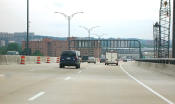 |
New Woodrow Wilson Bridge, heading westbound toward
Virginia. |
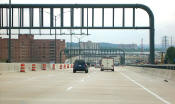 |
New Woodrow Wilson Bridge, heading westbound toward
Virginia. The Hunting Towers apartment complex is visible ahead to the left. |
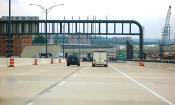 |
New Woodrow Wilson Bridge, heading westbound toward
Virginia. The Hunting Towers apartment complex is visible ahead to the left.
The Virginia end of the bridge is ahead. The under construction and partially
completed Washington Street Urban Deck,
is visible in the distance. |
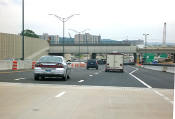 |
I-95/I-495 Capital Beltway, heading westbound
in Virginia. The Virginia end of the bridge is visible in the foreground where
the asphalt (dark) pavement meets the concrete (light brown) bridge roadway
deck. Approaching the under construction Washington Street Urban Deck, on
the new 3-lane roadway that takes the Beltway under the completed southern
section of the deck that, when all work is complete, will carry the local
and express roadways of the Beltway Outer Loop (toward Wilson Bridge). |


















